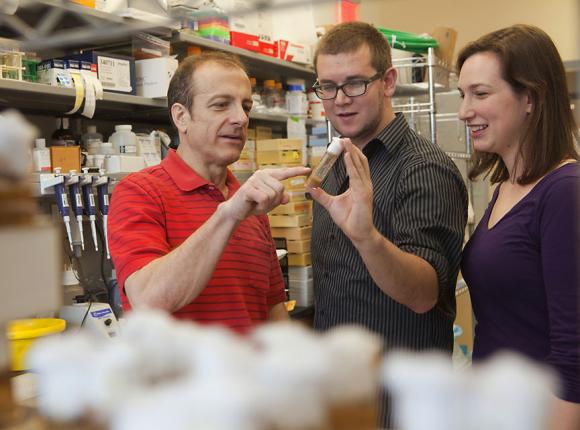People typically regard these as the same thing, but biology Professor Robert Reenan needed an epiphany before he could have his eureka moment.
EUREKA — “Exceptional, Unconventional Research Enabling Knowledge Acceleration” — is the name of a rare and competitive grant that Reenan recently won from the National Institutes of Health. Beginning April 1, Reenan will use the four-year, $1.3-million award to look for genes that can suppress seizures in fruit flies that he has cleverly engineered to mimic human epilepsy.
The epiphany, which came a few years ago, was about the surprising genetic similarity between fruit flies and people. For years Reenan has conducted basic gene expression research on a particular fruit fly gene nicknamed “para” that governs how sodium ions can trigger brain cells to electrically signal muscles to move. Ominously, the gene’s name is short for paralytic.
“I’d known for years that there are sodium channel-related genes in humans,” he said. “One day, I thought, ‘I should check out what’s the closest human homolog of the para gene.’ So I did that.”
Febrile seizures
Fruit flies with a genetic tendency toward fever-induced seizures (top) are the first to stop moving freely and are swept aside by a gentle air current as the temperature rises.
Credit: Reenan Lab/Brown University
He found a very close match between para and the human gene SCN1A. Subsequently he found that mutations on that gene underlie forms of epilepsy including the childhood forms generalized epilepsy with febrile (fever-triggered) seizures and severe myclonic epilepsy of infancy.
Reenan realized that if he could precisely and reliably create the epilepsy mutations found in the human SCN1A gene in the fruit fly para gene, he’d have a mass producible platform for genetic research into the disease. Fruit flies can be bred, engineered and observed by the thousands, and his flies would be genetically meaningful stand-ins for people.
Now that he’s succeeded in making flies that mimic human epilepsy, his goal is to breed and observe the mutant flies in ways that intentionally mutate them further. Maybe one of those mutations will suppress the disease.
A unique technique
The trick, one that the NIH reviewers found to be “exceptional and unconventional” enough to support with the EUREKA grant, was making the epileptic flies in the first place. Reenan uses a technique called “homologous recombination.” It’s an established practice, but one that most other biologists find tricky and cumbersome. Reenan, however, has it down to a science.
When biologists have a mutation to insert, they often use a “transgenic” technique that employs a bacterium or a virus to stuff a copy of a gene, or maybe a few, into a random location on a random chromosome in a embryonic cell. It can produce interesting results once the engineered organism develops, Reenan said, but it’s an inexact way to instill a genetically inherited disease.
Because the transgenic method is a way to break genetic material into an embryonic cell, Reenan uses it as the first step in a more sophisticated genetic rearrangement. For the job, Reenan’s mutant snippets of DNA carry a few special tools. One is a gene on each end that allows the snippets to break free from wherever they first land and to float around the cell. Another is the gene to give the flies red eyes.
The mutant snippet very closely resembles the unmutated para gene, so when it is floating freely, it will be picked up by the cell’s natural DNA repair machinery and plopped into exactly the right place on the right chromosome. In this way the fly embryos are more likely to grow up to have engineered epilepsy.
In almost every fly where the rearrangement works, the fly’s eyes turn out a tell-tale red instead of their usual white. To find the flies with the epilepsy mutation, undergraduates in Reenan’s lab merely need to look for the flies with the red eyes.
Cast of thousands
As Reenan and his group create and breed more and more epileptic flies, they can build a large enough population to induce mutations with chemical mutagens or radiation. Somewhere in all that genetic code that thousands of flies carry around, he’s betting, some switch will flip and a mutation will turn out to interfere with epilepsy and suppress seizures in flies that were created to have them. In essence, the flies will then contain what he calls “a genetic cure.”
This is clearly a methodology that cannot be employed with people, but given the genetic overlap between para and SCN1A, if there’s a genetic means to combat epilepsy in people, Reenan’s flies might reveal it.
“With epilepsy, the treatments are generally fairly broad and with a lot of side effects and we don’t really understand epileptigenesis — why do seizures happen, how are we going to treat them,” Reenan said. “So the idea is pretty simple. Let’s just use standard fruit fly suppressor genetics and find mutations that suppress or cure the seizures.”

